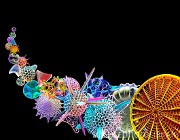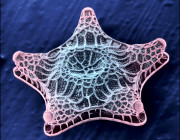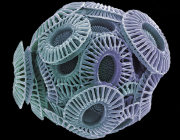Home :: List of Publicly Available Datasets :: Pyrocystis lunula CCCM 517
Pyrocystis lunula CCCM 517
Downloads:
| Principle Investigator(s) | Juan Saldarriaga |
|---|---|
| External sample ID | Pyrlun |
| NCGR Sample ID | MMETSP0229_2 |
| Sample accession number | CAM_SMPL_002474 |
| Assembly accession number | CAM_ASM_000292 |
| Combined Assembly Name | N/A |
| Genus | Pyrocystis |
| Species | lunula |
| Strain | CCCM 517 |
| Clonal | Unknown |
| Axenic | No |
| Prelim. NCBI Taxon ID | 2972 |
| 18S rRNA | |
| Importance of organism and transcriptomes | Pyrocystis lunula is interesting for two main reasons. First, it is one of very few dinoflagellates that spend the majority of their time as metabolically active cysts and not in their flagellated stage. Second, it is also an intensely bioluminescent species that has served as a model system to study this process as well as circadian rhythms. |
| Additional citations and references | Swift, E. & Taylor, W.R. (1967). Bioluminescence and chloroplast movement in the dinoflagellate Pyrocystis lunula. Journal of Phycology 3: 77-81. |
| Environmental Data | |
| Primary citation for organism's characterization, if available | Heimann, K., Klerks, P.L. & Hasenstein, K.H. (2009). Involvement of actin and microtubules in regulation of bioluminescence and translocation of chloroplasts in the dinoflagellate Pyrocystis lunula. Botanica Marina 52(2): 170-177 |
| Sample material (e.g. "seawater," "sediment," etc.) | seawater |
| Habitat | marine habitat |
| Experimental Data | |
| Date of experiment | 02-JUN-11 |
| Growth medium | HESNW |
| Modifications to growth medium | no silica |
| Temperature (ºC) | 23 |
| Salinty (psu) | 30 |
| pH | 7 |
| Light (µmol photons / m2 / sec) | 3800 |
| Day portion of day:night cycle in hours | 14 |
| Night portion of day:night cycle in hours | 10 |
| Nitrate (μmol/L) | 3 |
| Ammonium (μmol/L) | .11 |
| Phosphate (μmol/L) | .3 |
| Investigation type | Eukaryotes |








